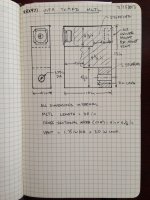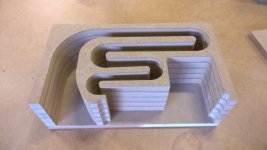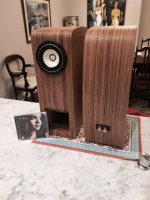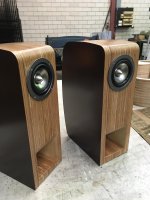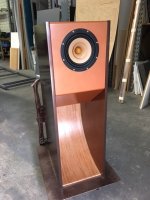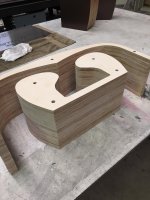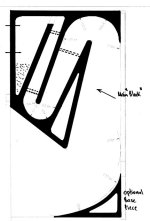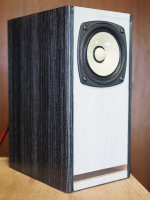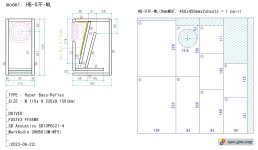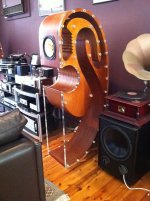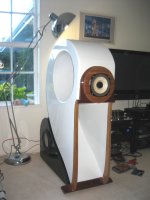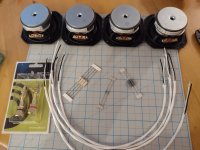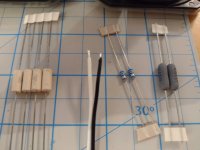Nat Sound,
here is the design for a compact folded MLTL using the Vifa. You can mount the driver so that the vent faces forward or backwards depending on your preference. Back vent if placed near wall can augment bass even more.
Regards,
X
I am unclear as to how to stuff this enclosure design when using the front vent (driver flipped to other side). Seems like you don't have a continuous 30" path to the vent like for the standard mount. Can you clarify?
Attachments
Greetings,
Firstly, let me thank you for graciously posting the design for this MLTL cabinet, XRK971. Awful nice of you, and everyone else, who posts such things for the rest of us to enjoy.
I'm building a pair of these for a friend who is hard-of-hearing. He recently complained that he had trouble hearing dialogue in TV and movies. From what I understand, small, wide-band, drivers, like this, do particularly well with vocal frequencies, partly due to absence of a crossover/second driver. Also, his downstairs neighbor will call the police on him any chance she gets. The great vocal frequency reproduction, along with them being devoid of bass, below a certain spot, seemed like it might be just right for his needs (or so I hope).
The drivers came in a while back, but the cabinets weren't yet built. I have been breaking in the TC9FD18-08's for about a month, with them just sitting on their backs, like sad turtles. They still sounded pretty darn good that way (being a modest 3" driver). Got the first pair of cabinets ready and I'm assembling them. Even with no stuffing and ports that aren't yet cut to spec, they sound pretty amazing. If I were you, I would have named these speakers the "Clown Cars." It doesn't seem possible they could produce the sound that emanates from them. Either my eyes, or my ears, are lying. There must be a trap door beneath the Mini Cooper, or something like that, right? I've looked and I can't find it. And there's no strain (as long as driven within reason, I'm sure). Anyway, I'm blown away at what a 3", $20, driver, and a small, simple, cabinet, can achieve.
I have a couple questions;
- I know the drawing shows where the stuffing goes, but wasn't sure how much to use. I bought a bag of Acousta-Stuf, but I've never stuffed my own speaker cab.
- How exact does the length of the port have to be? Presently, they're closer to 3 1/4", but I could always take the saw to them, again.
I'll post pictures once they're finished.
Firstly, let me thank you for graciously posting the design for this MLTL cabinet, XRK971. Awful nice of you, and everyone else, who posts such things for the rest of us to enjoy.
I'm building a pair of these for a friend who is hard-of-hearing. He recently complained that he had trouble hearing dialogue in TV and movies. From what I understand, small, wide-band, drivers, like this, do particularly well with vocal frequencies, partly due to absence of a crossover/second driver. Also, his downstairs neighbor will call the police on him any chance she gets. The great vocal frequency reproduction, along with them being devoid of bass, below a certain spot, seemed like it might be just right for his needs (or so I hope).
The drivers came in a while back, but the cabinets weren't yet built. I have been breaking in the TC9FD18-08's for about a month, with them just sitting on their backs, like sad turtles. They still sounded pretty darn good that way (being a modest 3" driver). Got the first pair of cabinets ready and I'm assembling them. Even with no stuffing and ports that aren't yet cut to spec, they sound pretty amazing. If I were you, I would have named these speakers the "Clown Cars." It doesn't seem possible they could produce the sound that emanates from them. Either my eyes, or my ears, are lying. There must be a trap door beneath the Mini Cooper, or something like that, right? I've looked and I can't find it. And there's no strain (as long as driven within reason, I'm sure). Anyway, I'm blown away at what a 3", $20, driver, and a small, simple, cabinet, can achieve.
I have a couple questions;
- I know the drawing shows where the stuffing goes, but wasn't sure how much to use. I bought a bag of Acousta-Stuf, but I've never stuffed my own speaker cab.
- How exact does the length of the port have to be? Presently, they're closer to 3 1/4", but I could always take the saw to them, again.
I'll post pictures once they're finished.
3.25in long is not a problem. Also, you should use a baffle step correction circuit. For 8ohm driver and a skinny cabinet use 1mH air core or iron core (cheaper) plus about 4.7ohms to 6.8ohm or to 8.2ohm resistor in parallel between amp and +ve terminal. This will attenuate the mids and highs in a shelving filter and balance the bass and highs. Adjust the resistor to taste. Speaker will sound less fatiguing and warmer.
Why? For hearing impaired we historically want the speaker to roll off below ~250 - 1 kHz depending on how impaired to attenuate/avoid any mids' 'fullness'/'mud'/'honk'.
FWIW, etc., I have pretty well balanced speakers angled down/toe'd in from above/outside the screen to a solo 'sweet spot', so no real room, etc., problems and more n' more I'm having to either turn them up and/or cover my ears with splayed fingers to roll off the lower BW to follow dialog (no functioning tone controls) , so BSC seems very counterproductive to me.
, so BSC seems very counterproductive to me.
FWIW, etc., I have pretty well balanced speakers angled down/toe'd in from above/outside the screen to a solo 'sweet spot', so no real room, etc., problems and more n' more I'm having to either turn them up and/or cover my ears with splayed fingers to roll off the lower BW to follow dialog (no functioning tone controls)
I've enjoyed the Fostex 108EZ 4-inch driver in a DIY CNC'd back loaded horn (first one in MDF, then Euro birch ply versions).
A mate also used Jordan drivers in my horn.
A mate also used Jordan drivers in my horn.
Attachments
I just want to be sure - we're talking about inductors here, correct? I'm no engineer - merely hanging off y'all's coattails. I've got a digikey cart going, with your recommendations, XRK. I think these inductors are what you'r referring to...For 8ohm driver and a skinny cabinet use 1mH air core or iron core [...]
https://www.digikey.com/en/products/detail/api-delevan-inc/2500-28J/3479912
And the larger of the two connector tabs on the driver is the positive lead? I can't find anything designating which is which.
Do the higher ohm resistors trim the higher frequencies, or the other way around? I'll give a baffle step correction circuit a try. Although, I tend to be quite sensitive to tinny/bright speakers, and I haven't noticed that with these TC9FD's at all. Perhaps because they don't get very loud? Or because I've been listening to them off axis all this time?
Like GM said: I may end up leaving baffle step correction off the set I give to my buddy. If I'm not mistaken, I understand that we lose our hearing starting with the higher frequencies, progressing downward. I believe this is a normal function that simply comes with age. On the other hand, the amp I'm providing along with the speakers does have basic tone controls. Perhaps I'll just aim for "flat-ish" and let him adjust to taste.
That's a really neat chart there, GM! It explains just about everything all in one go - very cool. I'll pretend like I understand all of it.
I guess the stuffing isn't all that critical? I'll just stuff 'em like turkeys and presume I'm making things better and not worse.
I've seen others, when making cabs for wide-band drivers, put emphasis on the benefits of a chamfer on the inner side of the driver hole. Would anything like that improve this design? I'd have to just cut something like that in by hand at this point. Might just make a huge mess.
Those are beautiful cabs, Atilsley! That cross section is really neat to see. Free shipping to The States with purchase, right? XD
Last edited:
Quilip, thanks....or you could use CAD file.....cheaper than OS freight...!! Of interest, those small horns went into a Home Theatre rig, using my BLH cabinets for fronts (with Tang Band W8-1772 8-inch woofers, with a horn-loaded centre channel, with same driver.
Attachments
Not really a horn, but a badly designed TL. And translam is such a waste.
A similar BH kit has been sold in Japan for about 25 years.
It seems to be selling well there because it is easy to assemble.
When I actually listen to it, I do not feel the goodness of a backload horn and the bass is cheap.
It certainly sounds like a poorly designed TL.
https://www.hasehiro.co.jp/sb/
A similar BH kit has been sold in Japan for about 25 years.
And i have been complaining about them for near that long.
dave
Last edited:
There are three ways of judging a speaker/stereo, for me:Not really a horn, but a badly designed TL.
1. The way they sound. Which usually happens AFTER they're bought and paid for. My experience is limited to a bunch of used, largely vintage, gear, over the years, and fumbling through learning how to actually set it all up.
2. The way they look. And those speakers do look pretty cool to me.
3. Objective testing, performed by others, and/or the opinions of others.
One way or the other, I'm very glad to have a whole forum of guys like this that truly care about the sound. Anything that dispels with marketing lies is helpful and appreciated.
Quilip, thanks....or you could use CAD file.....cheaper than OS freight...!! Of interest, those small horns went into a Home Theatre rig, using my BLH cabinets for fronts (with Tang Band W8-1772 8-inch woofers, with a horn-loaded centre channel, with same driver.
That center channel looks super cool, too!
Beauty is in the eyes of the beholder. And WAF is in the blah, blah, blah - something about my wife's eyes and how speakers like this aren't allowed in the house 
I happen to think they're super cool looking. But, then, I have a vague understanding of WHY they look the way they do. Which makes me wonder if I'd still feel that way if that weren't the case. I guess I'm more "function before form" in this instance. The function precedes and informs my appreciation for their looks. That last one looks like an assault snail.
I anxiously await the more technical guys and their dry, factual, judgement.
I happen to think they're super cool looking. But, then, I have a vague understanding of WHY they look the way they do. Which makes me wonder if I'd still feel that way if that weren't the case. I guess I'm more "function before form" in this instance. The function precedes and informs my appreciation for their looks. That last one looks like an assault snail.
I anxiously await the more technical guys and their dry, factual, judgement.
Well, the physics of the situation is that T/S theory peters out at the driver's upper mass corner (Fhm = 2*Fs/Qts'), so the driver box is an acoustic low pass filter coupling it to a horn that only loads from whatever low corner frequency chosen up to its Fhm, so as such we ideally want the driver in the horn's terminus a certain amount to make as coherent as practical a transition from horn to driver mids/HF BW.
(Qts'): (Qts) + any added series resistance (Rs): http://www.mh-audio.nl/Calculators/newqts.html
If Fhm is low enough (physically big enough sound 'bubble') to allow the driver to be some distance from the horn's acoustic center, then it can be above the terminus.
Note too that with the terminus setting flush on a sufficiently rigid/massive enough surface will be mirror imaged, i.e. 2x mouth area, = drops the horn's cutoff a half octave (0.707x F0).
That said, its incidence angle is such to in theory 'force' a blend with the driver's output in its acoustic crossover to increase perceived coherence at the listening position, but never having experimented with it, no clue how well it performs, though with modern simming software I imagine it can be fine tuned to a fare-thee-well nowadays.
Last, but not least, the circular hole if sufficiently round it will generate a ~one note eigenmode that could be audible, adding some room noise, though again no experience.
(Qts'): (Qts) + any added series resistance (Rs): http://www.mh-audio.nl/Calculators/newqts.html
If Fhm is low enough (physically big enough sound 'bubble') to allow the driver to be some distance from the horn's acoustic center, then it can be above the terminus.
Note too that with the terminus setting flush on a sufficiently rigid/massive enough surface will be mirror imaged, i.e. 2x mouth area, = drops the horn's cutoff a half octave (0.707x F0).
That said, its incidence angle is such to in theory 'force' a blend with the driver's output in its acoustic crossover to increase perceived coherence at the listening position, but never having experimented with it, no clue how well it performs, though with modern simming software I imagine it can be fine tuned to a fare-thee-well nowadays.
Last, but not least, the circular hole if sufficiently round it will generate a ~one note eigenmode that could be audible, adding some room noise, though again no experience.
- Home
- Loudspeakers
- Full Range
- Fostex FE83En the right small box?
